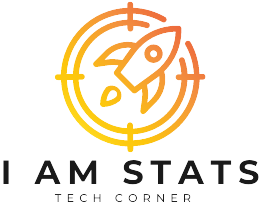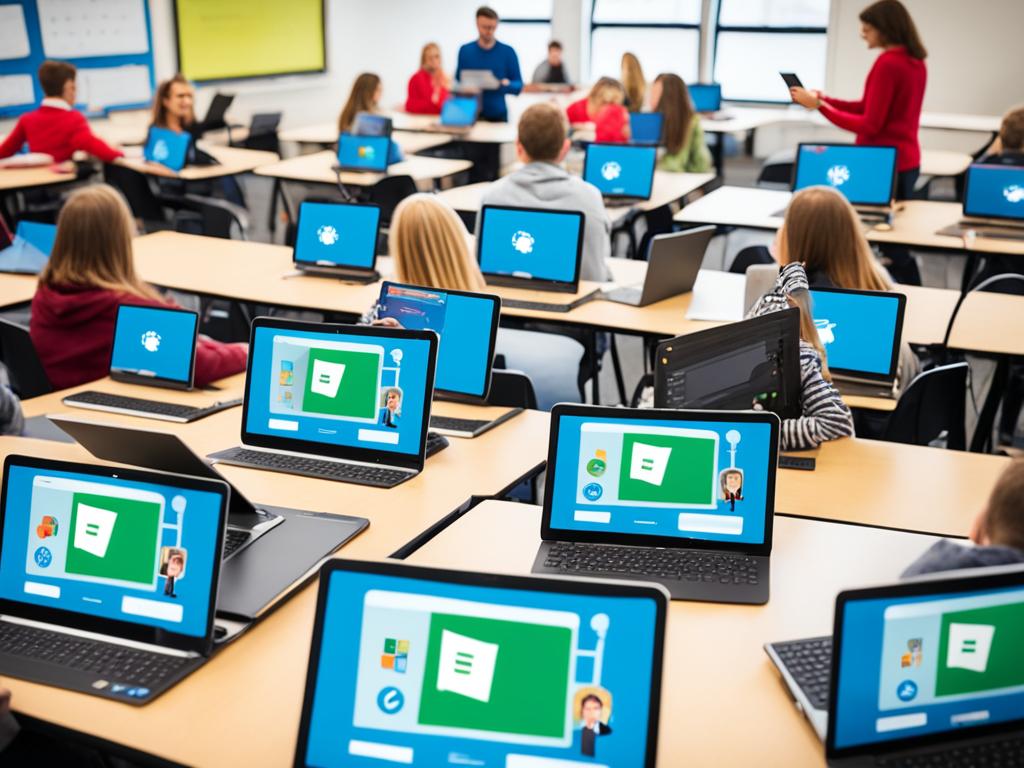Welcome to the era of technology-driven education! In today’s classrooms, technology is revolutionizing the way we learn and teach. With the rise of digital tools, platforms, and innovative learning methods, students and educators alike are benefiting from an enhanced educational experience. Let’s dive into the world of tech in education and explore the tools for digital learning and the exciting digital learning methods that are shaping the future.
Key Takeaways:
- Technology is playing a pivotal role in transforming the education landscape.
- Digital tools and platforms are revolutionizing traditional teaching and learning methods.
- Online learning and virtual classrooms offer increased accessibility and personalized learning experiences.
- Virtual and augmented reality are transforming education by creating immersive and interactive learning environments.
- The potential for further advancements and innovation in tech-driven education is limitless.
The New Face of Education: EdTech Tools Reshaping Learning and Teaching.
Education is constantly evolving, and with the rapid advancement of technology, traditional teaching methods are being revolutionized. EdTech tools have emerged as powerful resources that are reshaping the way students learn and teachers instruct.
These innovative tools have a profound impact on both learning and teaching by enhancing engagement, collaboration, and personalization. The integration of edtech tools in the classroom has opened up new possibilities for educators to create dynamic and interactive learning experiences.
One of the key benefits of edtech tools is their ability to boost student engagement. With gamification features, interactive content, and multimedia resources, students are motivated and excited to actively participate in their own learning. This increased engagement leads to better retention and comprehension of educational material.
Collaboration is another area where edtech tools are reshaping education. Virtual classrooms and digital platforms enable students to collaborate with their peers, whether they are in the same physical location or miles apart. Through video conferencing, instant messaging, and collaborative projects, students can work together to solve problems and share ideas, fostering a sense of teamwork and developing vital communication skills.
Personalization is a fundamental aspect of edtech tools that enhances the learning experience for each individual student. Adaptive learning platforms use algorithms to analyze students’ strengths, weaknesses, and learning styles. This data-driven approach allows for customized learning pathways, ensuring that students receive content and activities that cater to their specific needs.
From interactive whiteboards and educational apps to virtual reality simulations, edtech tools empower teachers to create immersive and dynamic lessons. These tools enable educators to deliver content in an engaging and interactive manner, captivating students’ attention and facilitating a deeper understanding of the subject matter.
EdTech tools have the power to reshape education by leveraging technology to enhance learning and teaching. By fostering engagement, collaboration, and personalization, these tools create an environment that nurtures students’ curiosity and supports their individual learning journey.
The Power of Interactive Learning Platforms.
Interactive learning platforms have revolutionized education, bringing about a new era of online learning and virtual classrooms. These platforms offer a range of benefits that enhance the learning experience for students of all ages.
One of the key advantages of interactive learning platforms is increased accessibility. Students no longer have to be physically present in a classroom to participate in lessons. Instead, they can access educational content and engage with their peers and instructors from anywhere in the world, as long as they have an internet connection. This level of accessibility opens up opportunities for remote learning, making education more inclusive and flexible.
Another advantage is the flexibility that interactive learning platforms provide. Students can learn at their own pace, pausing and rewinding lessons as needed. This individualized approach to learning allows students to focus on areas where they need more support while progressing quickly through concepts they grasp easily. The flexibility of online learning also means that students can fit education into their busy schedules, balancing work, family, and other commitments.
Personalized learning experiences are also facilitated by interactive learning platforms. These platforms often incorporate adaptive learning technologies, which use data and analytics to tailor instructional content to each student’s unique needs and learning style. By providing targeted feedback and personalized recommendations, these platforms can help students achieve their full potential, building confidence and motivation.
Virtual classrooms, a key component of interactive learning platforms, have become increasingly popular. These virtual classrooms recreate the collaborative environment of a traditional classroom, allowing students and instructors to interact in real time. Through features like chat functionality, whiteboards, and breakout rooms, students can engage in discussions, ask questions, and participate in group activities, fostering a sense of community and encouraging active learning.
Online Learning Benefits:
- Increased accessibility for students worldwide
- Flexibility to learn at your own pace
- Personalized learning experiences tailored to individual needs
- Opportunities for collaborative learning through virtual classrooms
Interactive learning platforms have transformed education, making learning more accessible, flexible, and personalized. With the power of online learning and virtual classrooms, students can embark on educational journeys that fit their individual needs and schedules, opening doors to new opportunities and empowering lifelong learning.
With the rise of interactive learning platforms, education is no longer confined to the four walls of a traditional classroom. Students can explore a world of knowledge at their fingertips, engaging in immersive and interactive learning experiences that foster critical thinking, collaboration, and creativity.
Virtual and Augmented Reality in Education.
Virtual reality (VR) and augmented reality (AR) are no longer limited to the realm of entertainment and gaming. These immersive technologies have found their place in the education sector, revolutionizing the way students learn and engage with information. By creating virtual environments and augmenting the real world with digital elements, VR and AR offer unique learning experiences that enhance understanding, spark curiosity, and promote creativity and innovation.
VR in education provides students with the opportunity to explore concepts and ideas in a simulated, three-dimensional environment. Whether it’s taking a virtual trip to historical sites, diving into the depths of the ocean, or exploring the vastness of outer space, VR transports students beyond the confines of the classroom and immerses them in interactive learning experiences. This technology enhances engagement and stimulates multiple senses, making learning more memorable and impactful.
On the other hand, AR in education seamlessly integrates digital content into the real world, enhancing students’ perception and understanding of complex concepts. By overlaying digital information onto physical objects, AR brings abstract ideas to life and provides visual, interactive aids for comprehension. Students can manipulate and interact with virtual objects, dissecting them or observing their intricate details up close. This hands-on approach fosters active learning, allowing students to explore at their own pace and gain a deeper understanding of the subject matter.
“The introduction of virtual and augmented reality in education has the potential to transform the way we teach and learn. These technologies create immersive and interactive experiences that cater to individual learning styles and foster creativity and critical thinking.” – Dr. Sarah Thompson, Education Specialist
One of the key benefits of VR and AR in education is their ability to bridge the gap between theory and practice. Instead of relying solely on textbooks and lectures, students can now experience real-world scenarios and apply their knowledge in a simulated environment. For medical students, VR can offer lifelike surgical simulations, allowing them to practice procedures without the risk associated with real patients. Similarly, engineering students can experiment with architectural designs in an immersive AR environment, visualizing their creations before they are built.
Furthermore, VR and AR in education promote inclusivity and accessibility. These technologies cater to different learning styles and allow students with diverse abilities and needs to actively participate in the learning process. Students who struggle with traditional teaching methods can thrive in immersive environments that cater to their strengths, fostering a sense of confidence and achievement.
The Potential of VR and AR in Education
The integration of VR and AR in education is still in its early stages, but the potential for growth and innovation is enormous. As technology continues to advance, we can expect to see more sophisticated and affordable VR and AR solutions that cater to a wider range of educational settings and subjects. From virtual field trips to remote locations to collaborative AR projects that foster teamwork, these immersive technologies have the power to reshape the way we teach and learn.
By embracing virtual and augmented reality in education, we empower students with new ways of learning and equip them with the skills required for the digital age. As the technology continues to evolve, we must explore its full potential and leverage it to create inclusive, engaging, and transformative learning experiences for all students.
| Benefits of Virtual and Augmented Reality in Education | Examples of Virtual and Augmented Reality in Education |
|---|---|
|
|
Conclusion.
In conclusion, technology is playing a significant role in revolutionizing education. The introduction of various tools, platforms, and digital learning methods are reshaping the way we learn and teach. EdTech tools are enhancing engagement, collaboration, and personalization in the classroom, empowering students and educators alike.
Interactive learning platforms, online learning, and virtual classrooms offer increased accessibility, flexibility, and personalized learning experiences. These platforms are bridging geographical barriers, allowing learners to connect and collaborate in new ways. The power of virtual and augmented reality in education cannot be overstated, as these immersive technologies create unique learning experiences, foster understanding, and unleash creativity.
While we have seen significant advancements in technology’s integration into education, there is still immense potential for further growth in this field. As technology continues to evolve, we can expect to see more innovative tools, platforms, and methods that will further enhance the learning and teaching experience.







